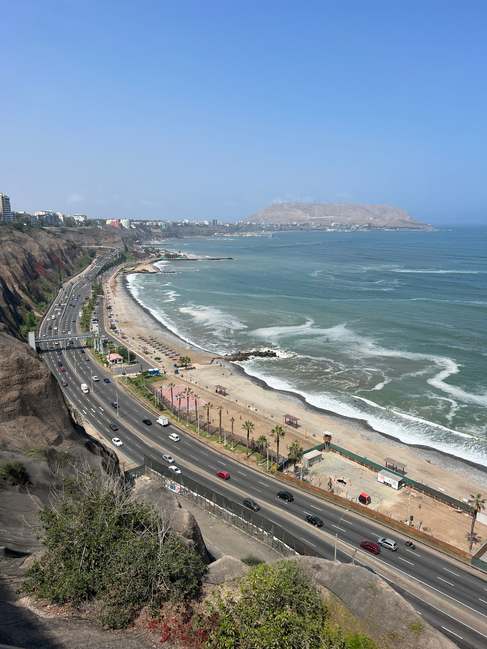Lima
- Will Gerson
- Aug 31, 2024
- 4 min read
Updated: Feb 18
Founded by the Spanish conquistador Francisco Pizarro as the Ciudad de los Reyes (City of Kings), Peru’s capital sits atop desert cliffs overlooking the Pacific Ocean and offers visitors a grand historic center, an unparalleled gastronomic scene, and a year-round temperate climate.

Centro Histórico
From its founding in 1535 through the 18th century, Lima was the jewel in the crown of the Spanish Empire in South America. As the capital of the Viceroyalty of Peru, the city was the continent’s foremost center of politics, religion, and economy, a key piece in a trading network stretching from Europe to the Americas and East Asia. Although the city has been the victim of several strong earthquakes over the last five centuries, it still boasts a magnificent historic center with some of the finest colonial buildings found anywhere in South America.

Start at the Plaza Mayor (or Plaza de Armas), the heart of the colonial city. Carlos V, Holy Roman Emperor and King of Spain, had decreed that all cities in the New World ought to be built on a grid centered around a square-shaped plaza, so it was here that Pizarro began his construction of the colonial city.

Today, the plaza is surrounded by stunning buildings on all sides. On the east side is the Catedral de Lima, built on the site of an Inca shrine and palace. Pizarro laid the foundation stone with his own hands, but the grand Renaissance-style cathedral that you see today was built over the course of nearly two centuries, finally completed in 1797. On the north side of the plaza is the Palacio de Gobierno, residence of the president of Peru. The current building dates to the 1920s, but it was constructed on the site of the original palace built by Pizarro in 1535 that served as the seat of power of the Viceroyalty of Peru. Other notable buildings here are the Palacio Arzobispal, attached to the cathedral, and the Palacio Municipal and Palacio de la Unión on the plaza’s west side; each showcases the ornate wooden colonial balconies that can be seen throughout the historic center.

A couple of blocks northwest of the Plaza Mayor is the Convento de Santo Domingo, one of a number of convents that can be found in the historic center.
Many religious orders came to Lima in the 16th century in hopes of evangelizing the native people, and the convents they founded played a central role in the social and cultural life of the city. However, one stands out the most: the Convento de San Francisco, just east of the Plaza Mayor. The monumental religious complex is the largest convent in the New World, and its beautiful architecture and opulent interiors are the product of collaboration between indigenous artisans and Spanish craftsmen. Don’t leave without touring the complex; you will also be taken underground to the catacombs, where tens of thousands of people were laid to rest from the 16th through 19th centuries.
Miraflores
Miraflores is one of Lima’s wealthiest districts and is a popular area for locals and tourists alike.
After enjoying the view while you stroll along the cliff top malecón (seafront promenade), come and indulge in some of the city’s world-class dining options––ceviche and other fresh seafood at La Mar; lomo saltado, ají de gallina, and other Peruvian classics at Panchita.
Don’t miss the chance to eat at a chifa, a traditional Chinese Peruvian restaurant. Peru received large numbers of Chinese and Japanese immigrants in the early 20th century, and they left an indelible mark on the country’s cuisine by combining Cantonese cooking with Peruvian ingredients and culinary traditions. This fusion style was highly influential on Peruvian cuisine as a whole, with many dishes being adopted into the mainstream: lomo saltado, one of the country’s most famous dishes, is a product of the chifas, consisting of strips of sirloin steak marinated stir fried in soy sauce with onions and tomatoes and served with rice and French fries. Pay a visit to Chifa Hou Wha at the northern edge of Miraflores; it would be hard to go wrong with your order, but I definitely recommend trying the arroz chaufa, Peruvian fried rice.
Barranco

Just south of Miraflores is the lovely district of Barranco, a neighborhood of calm, shady streets lined with grand casonas with an appealing array of dining and nightlife options. Barranco has long been home to a large artistic community (notably Nobel laureate Mario Vargas Llosa), and you will find artisan craft shops and fairs along its picturesque streets, including along the Bajada de Baños passing underneath the Puente de los Suspiros leading down to the beach. With a premier food and drink scene as well, Barranco is an ideal place to stay during your trip.

Barranco is home to fine-dining gem Central, ranked as the #1 in the 2023 edition of the World’s 50 Best Restaurants, but I highly recommend a meal at Isolina Taberna Peruana, where you should order the seco de asado de tira con arroz y frejoles, a slow-cooked strip roast covered with a delicious coriander sauce and served with rice and beans. Trust me, you won’t regret it.



















